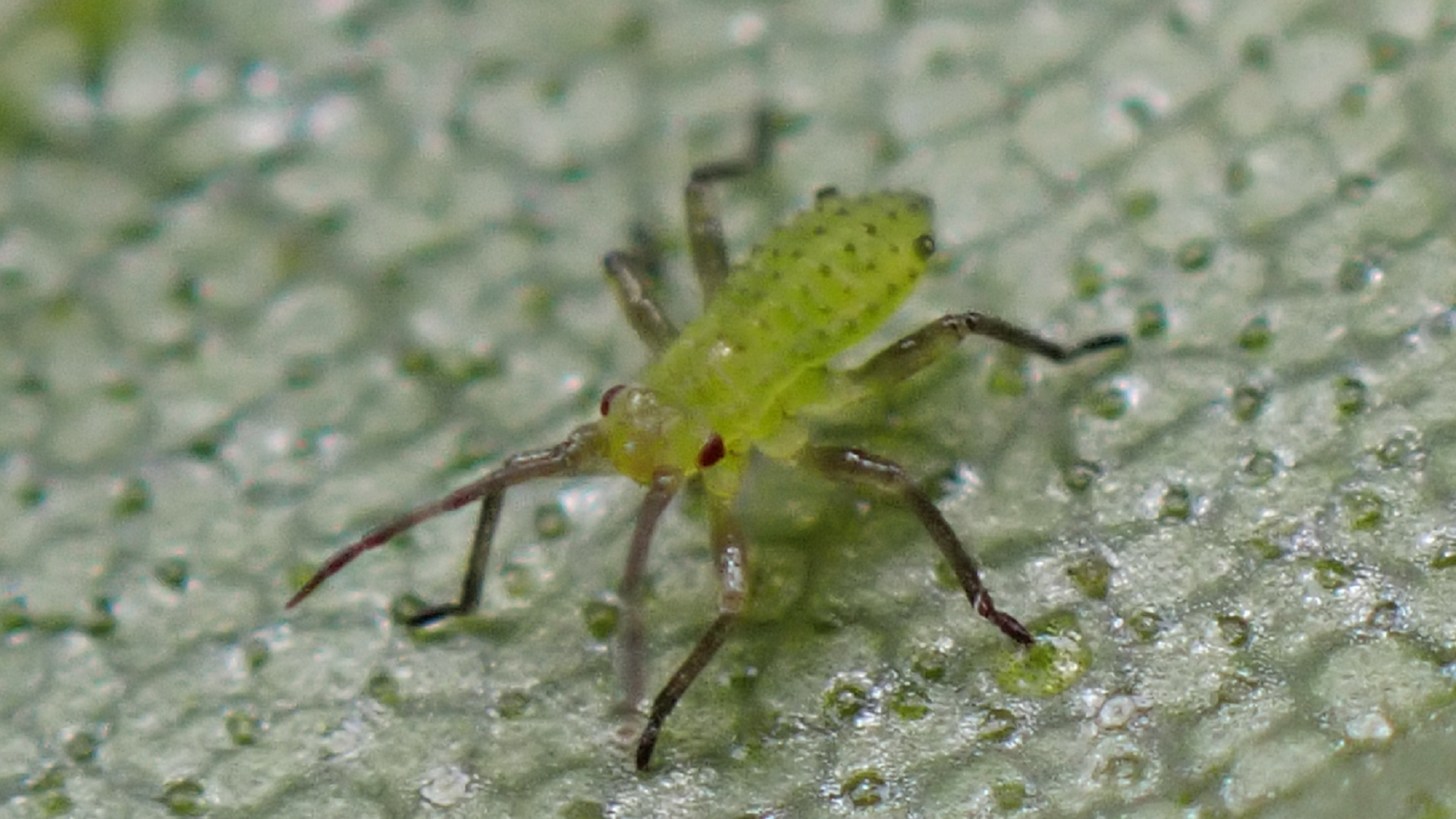MAY 2025
Garden Warbler
Sylvia borin
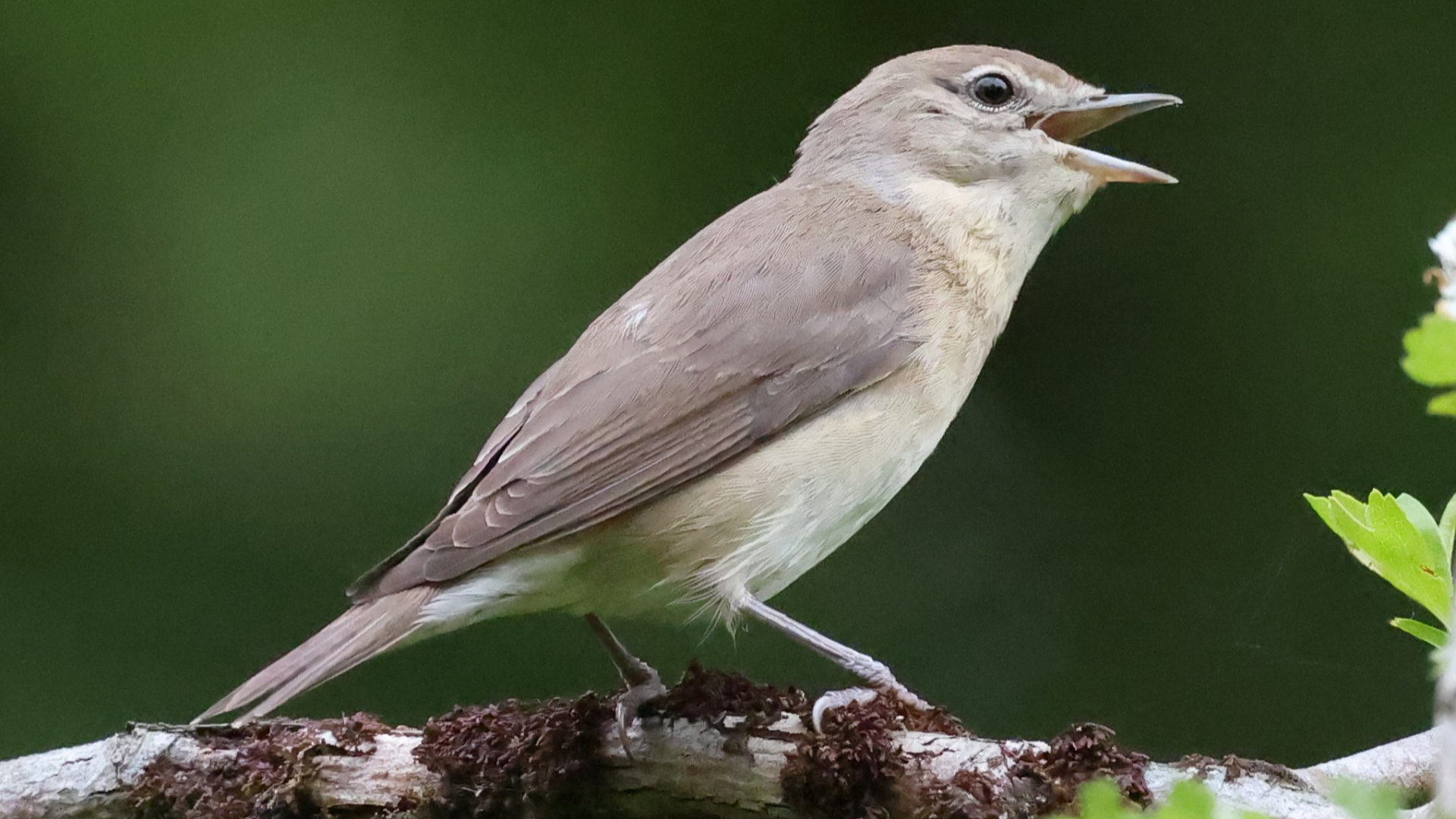
TQ4893 09/05/2025 ©Michael Trump
The Garden Warbler is a very plain bird that visits Britain in the summer months. Its name is misleading because it prefers the cover of trees and bushes in woodland where it feeds on insects and berries. This is the first record the website has for Hainault Forest.
Blackcap
Sylvia atricapilla

TQ4793 08/05/2025 ©Michael Trump
The Blackcap is a greyish bird that belongs to the Warbler family. Males have black caps while those of females are chestnut brown. It is mainly a summer visitor from Europe, but now more are spending winter in Britain.
Blackbird
Turdus merula
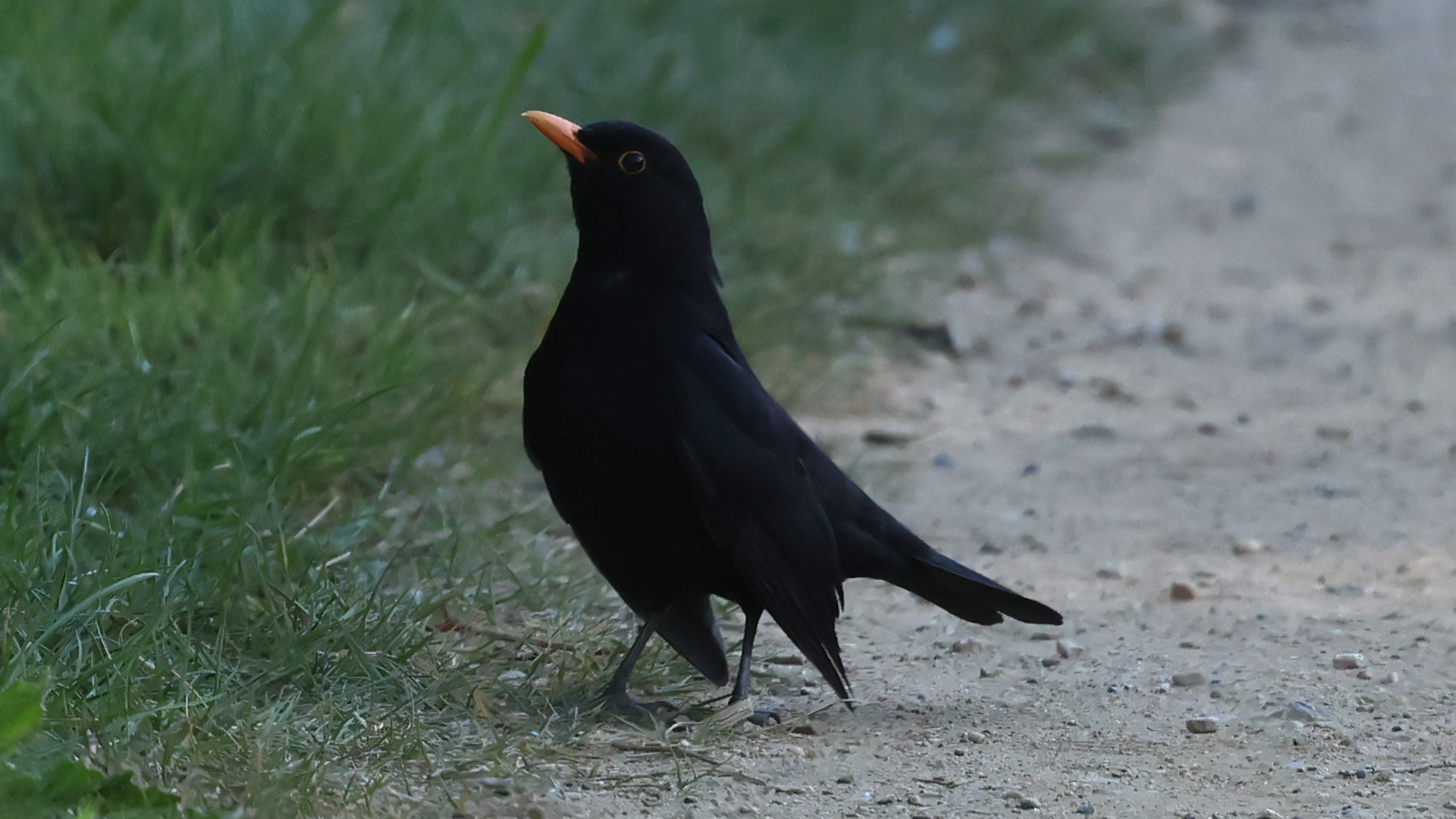
TQ4792 11/05/2025 ©Michael Trump
The Blackbird is a member of the Thrush Family that feeds on insects and berries. Males are black with a yellow bill and yellow ring around the eye. Females are dark brown.
MOVIE
Canada Goslings
Lesser Black-backed Gull
Larus Fuscus

TQ4590 17/05/2025 ©Debi H
Debi was at Fairlop Waters when a Lesser Black-back Gull grabbed a gosling. The young gosling was swallowed whole!
Coot
Fulica atra
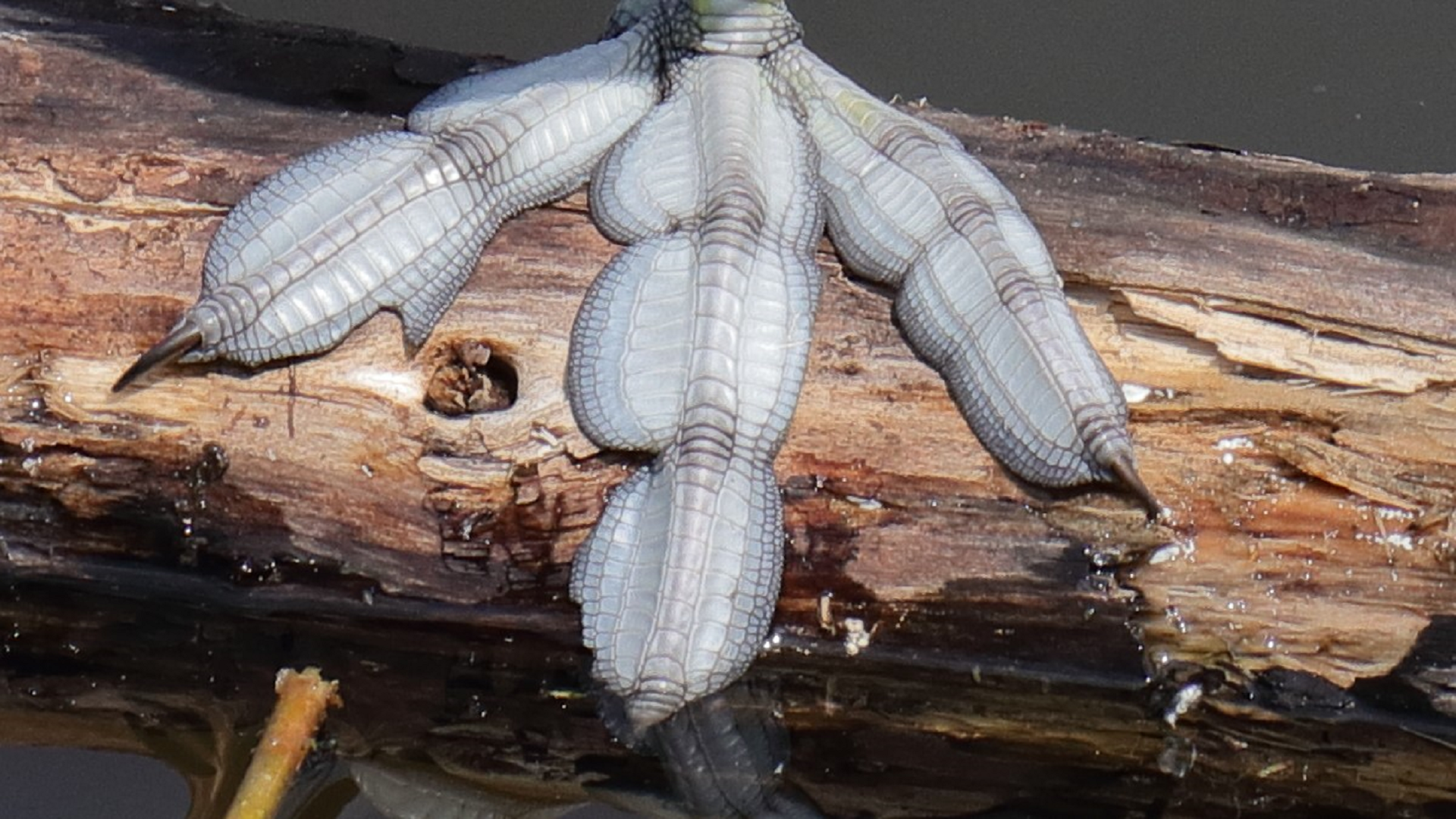
TQ4792 ©Mike Rumble
The coot does not have webbed feet, however it does have webbed toes. Every toe has a hinged flap that increases the foot’s surface area to provide better propulsion when swimming. When walking the fold-away flaps allow the coot to move more elegantly than if it had webbed feet similar to those of a duck.
Lime Hawk-moth
Mimas tiliae
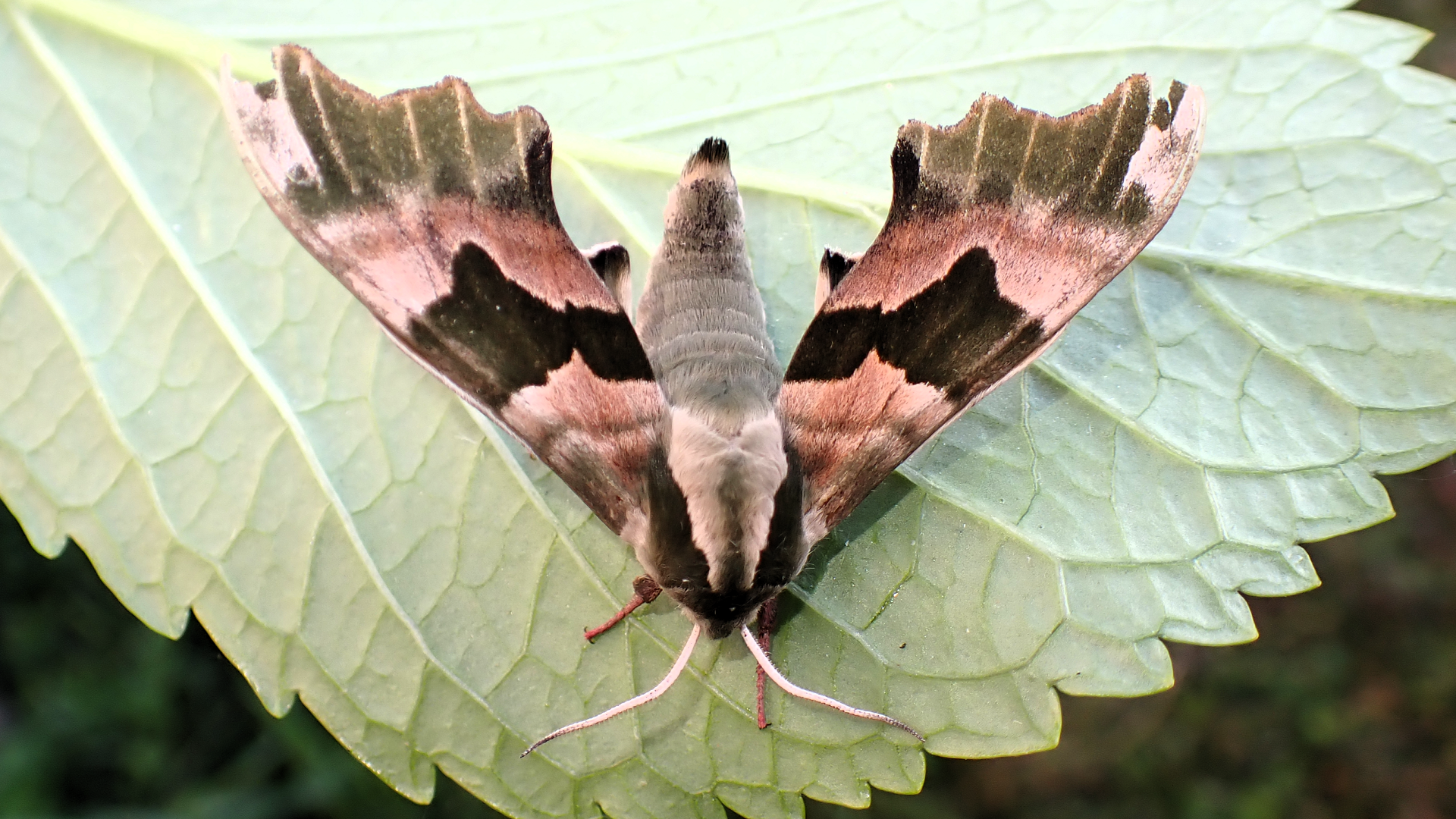
TQ4692 01/05/2025 ©Raymond Small
The Lime Hawk-moth is a large distinctive green and pink moth,
usually on the wing from May until July. There is also a common red-brown form with brick-red central markings (f. brunnea). Foodplants include lime, elm, birch and alder.
Hedge Beauty
Alabonia geoffrella
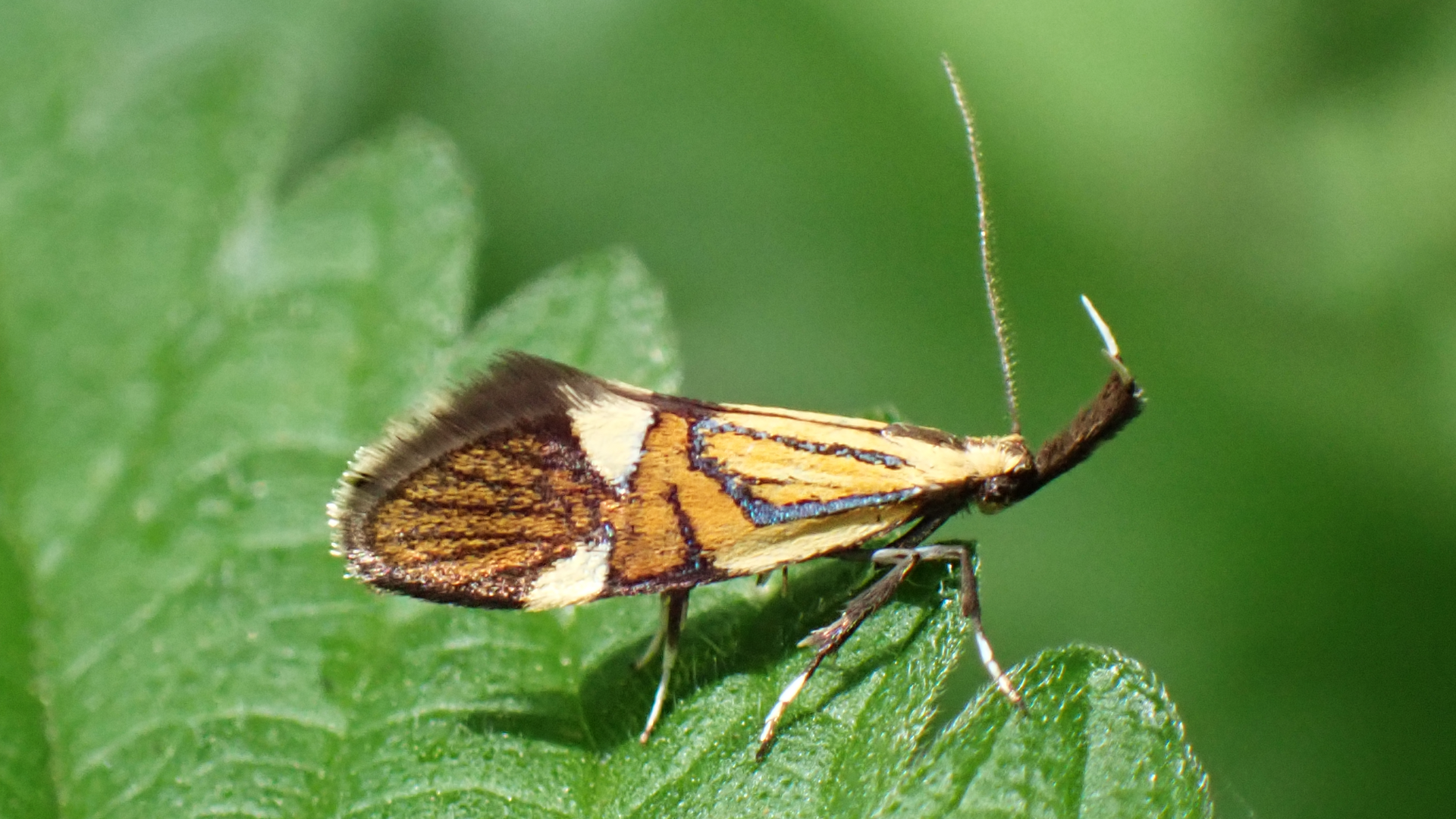
TQ4892 17/05/2025 ©Raymond Small
The Hedge Beauty is a colourful day-flying woodland species often seen in May and June on bramble during sunny mornings. Its larvae feed on rotten tree bark. Formerly known as the 'Common Tubic' and often referred to as "Geoff" by moth enthusiasts.
Silver Grass-miner
Elachista argentella
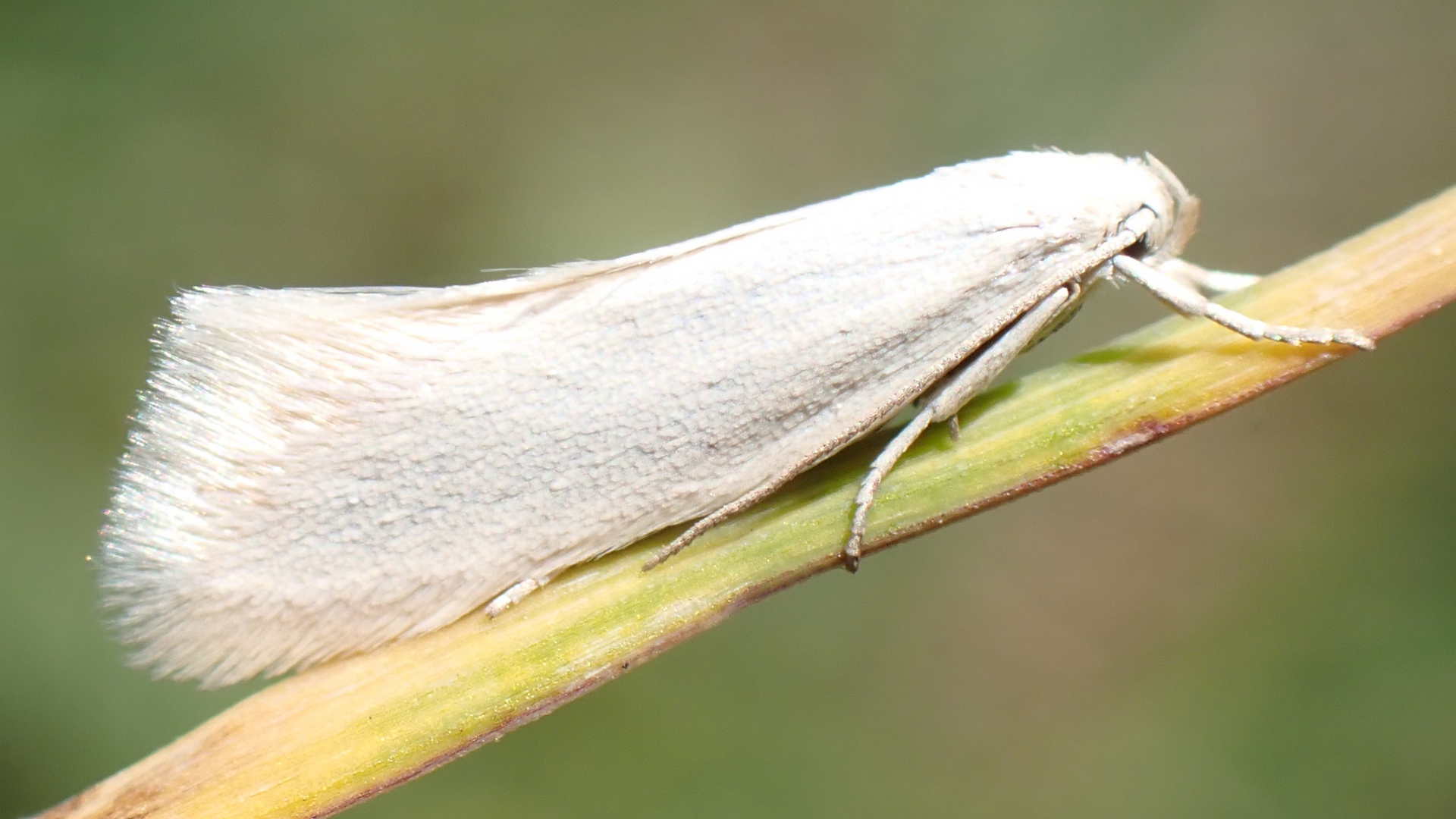
TQ4792 13/05/2025 ©Raymond Small
The Silver grass-miner flies from May until August and is often disturbed in grassland areas. Its larvae feed on various grasses. Previously known as the Swan-feather Dwarf.
Mother Shipton
Callistege mi
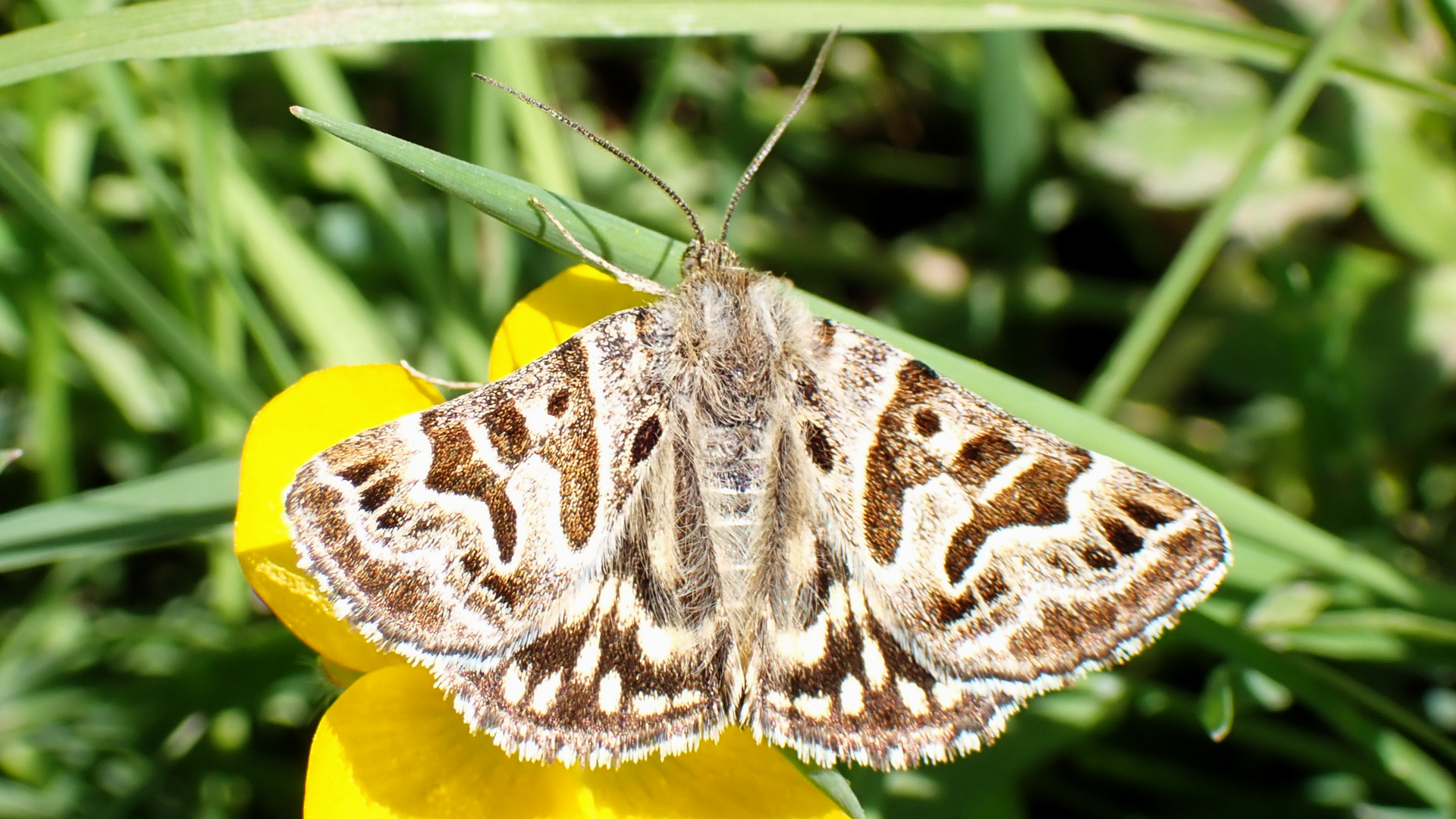
TQ4792 16/05/2025 ©Raymond Small
Day-flying moth found in meadows when the sun shines. Its name is a reference to 'Old Mother Shipton', the 16th Century witch whose face can be seen on the wings.
Emperor Moth
Saturnia pavonia

TQ4792 25/05/2025 ©Raymond Small
When the larvae are fully grown they turn green and black with yellow spots.
Green Hairstreak
Callophrys rubi
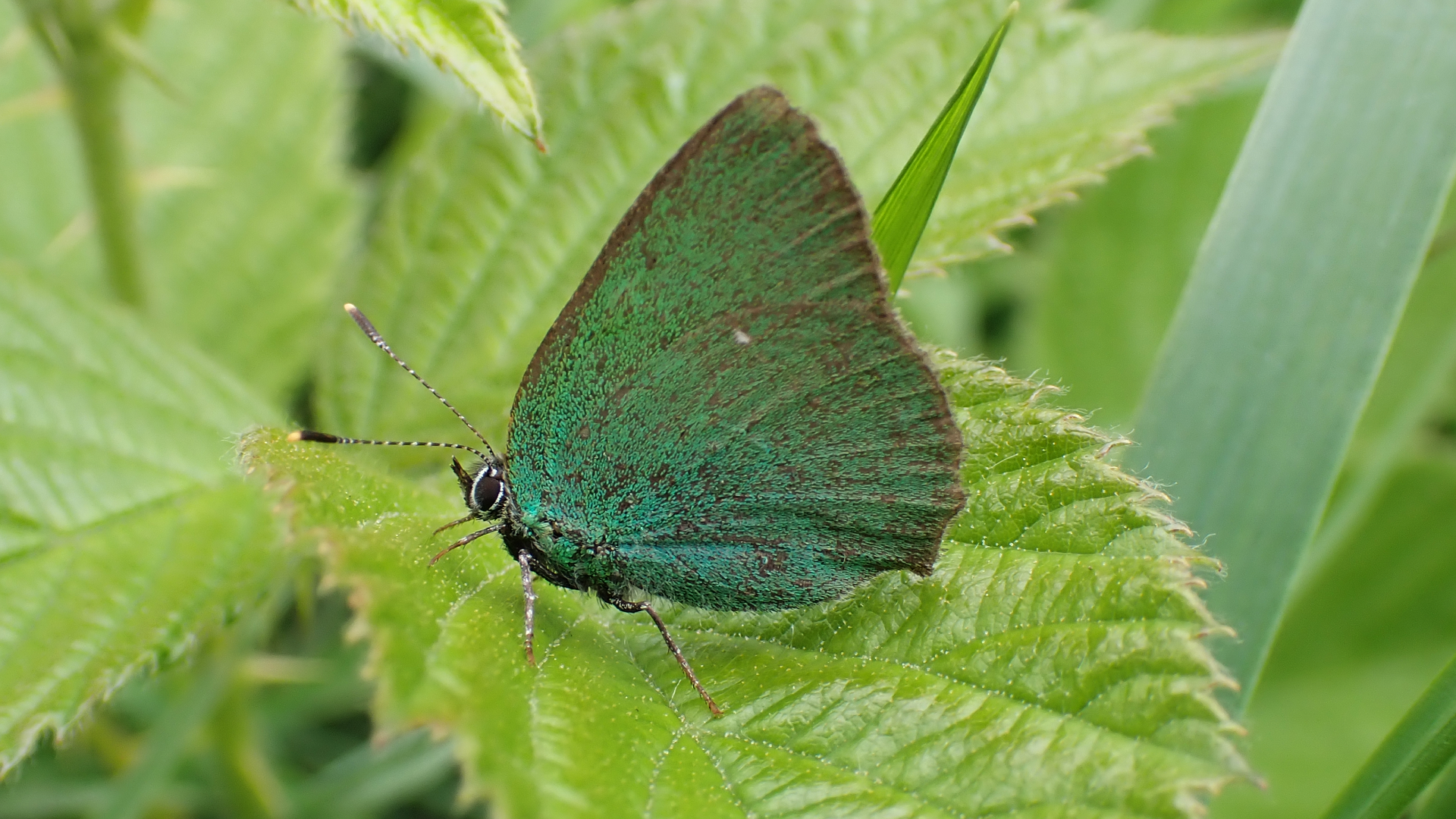
TQ4792 26/05/2025 ©Raymond Small
The Green Hairstreak butterfly rests with its wings closed. The white streak on the wings is sometimes absent in some specimens.
Green-veined White
Pieris napi

TQ4793 11/05/2025 ©Raymond Small
The Green-veined White is a common butterfly that flies from April until October. It is found in a wide range of habitats, especially damp areas with lush vegetation. Its caterpillars feed on plants in the Cabbage family.
Small Heath
Coenonympha pamphilus
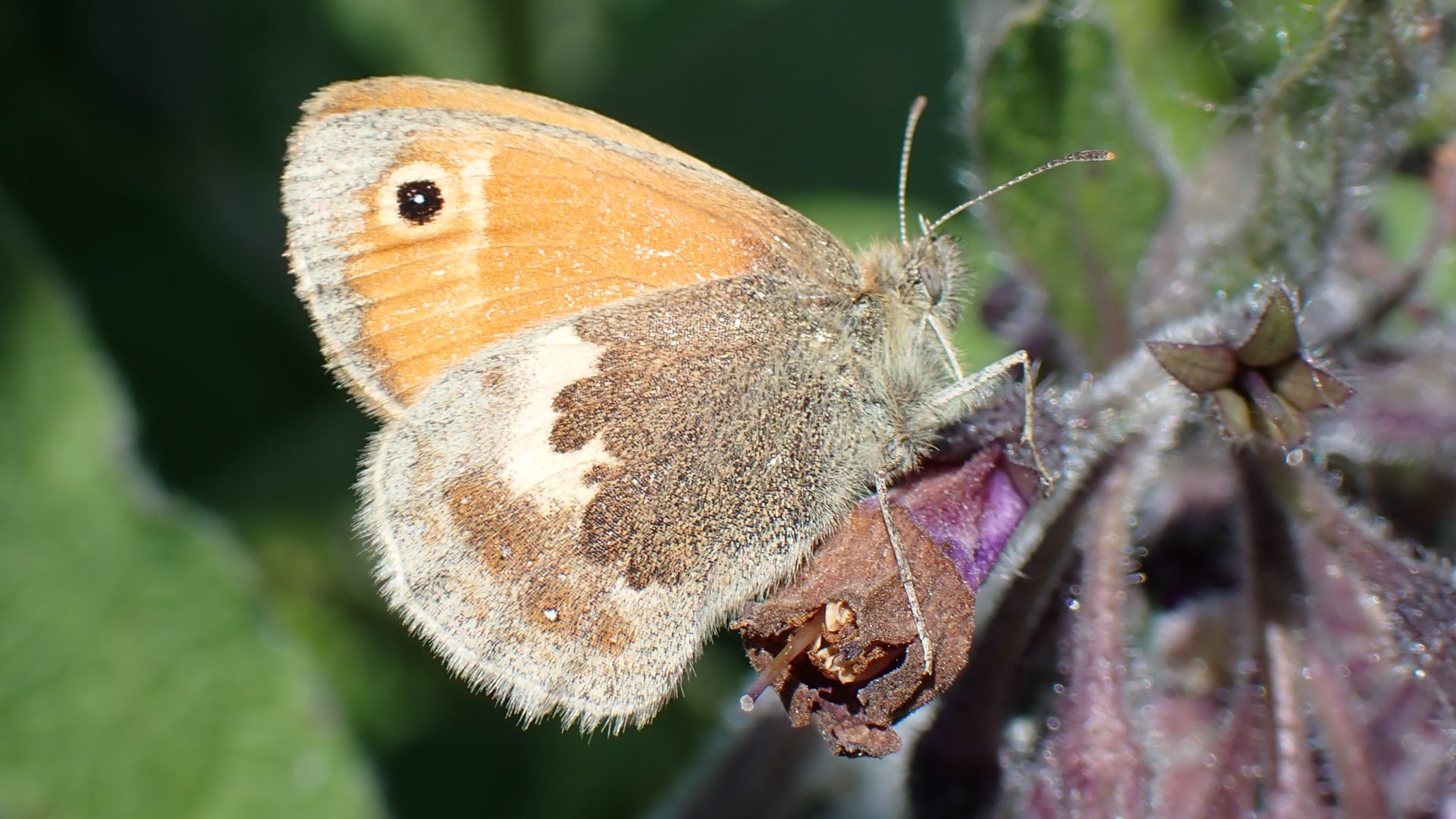
TQ4792 23/05/2025 ©Raymond Small
The Small Heath is the smallest of the UK's brown butterflies. It has a fluttering flight and often rests leaning to one side. This species has a preference for heathland in sunny locations.
Mottled Sedge Caddisfly
Glyphotaelius pellucidus
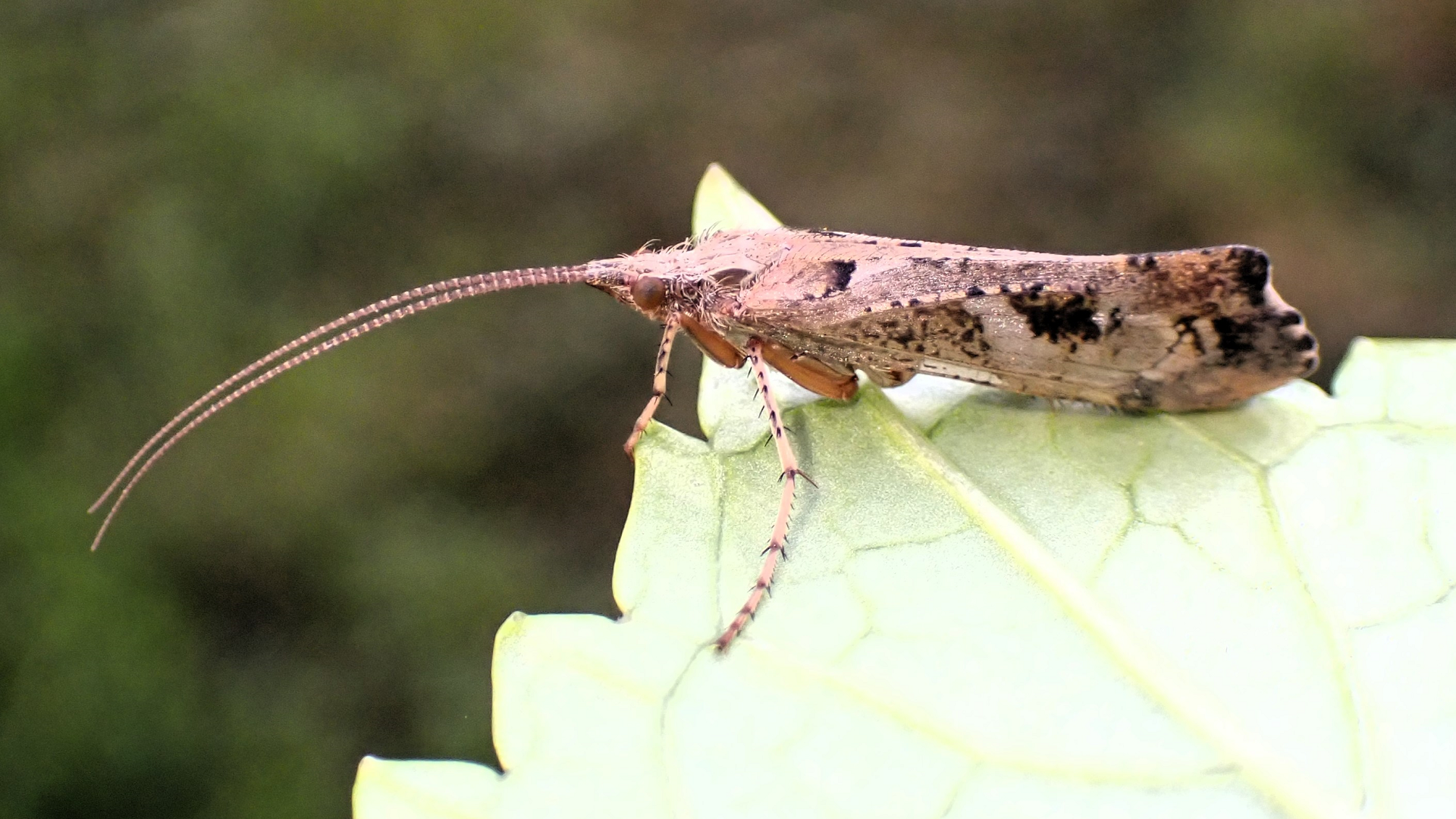
TQ4692 01/05/2025 ©Raymond Small
Adult Caddisflies usually live for a couple of weeks during which they do not feed. They die soon after mating. Their larvae are aquatic creatures that feed in freshwater habitats. Glyphotaelius pellucidus has a diagnostic notch on the outer edge of the brown forewings. Males have light and dark markings which are mainly missing in females. Adults fly May to June and again from August to October. This species inhabits woodland usually near streams and ponds.
Golden-bloomed Grey Longhorn
Agapanthia villosoviridescens
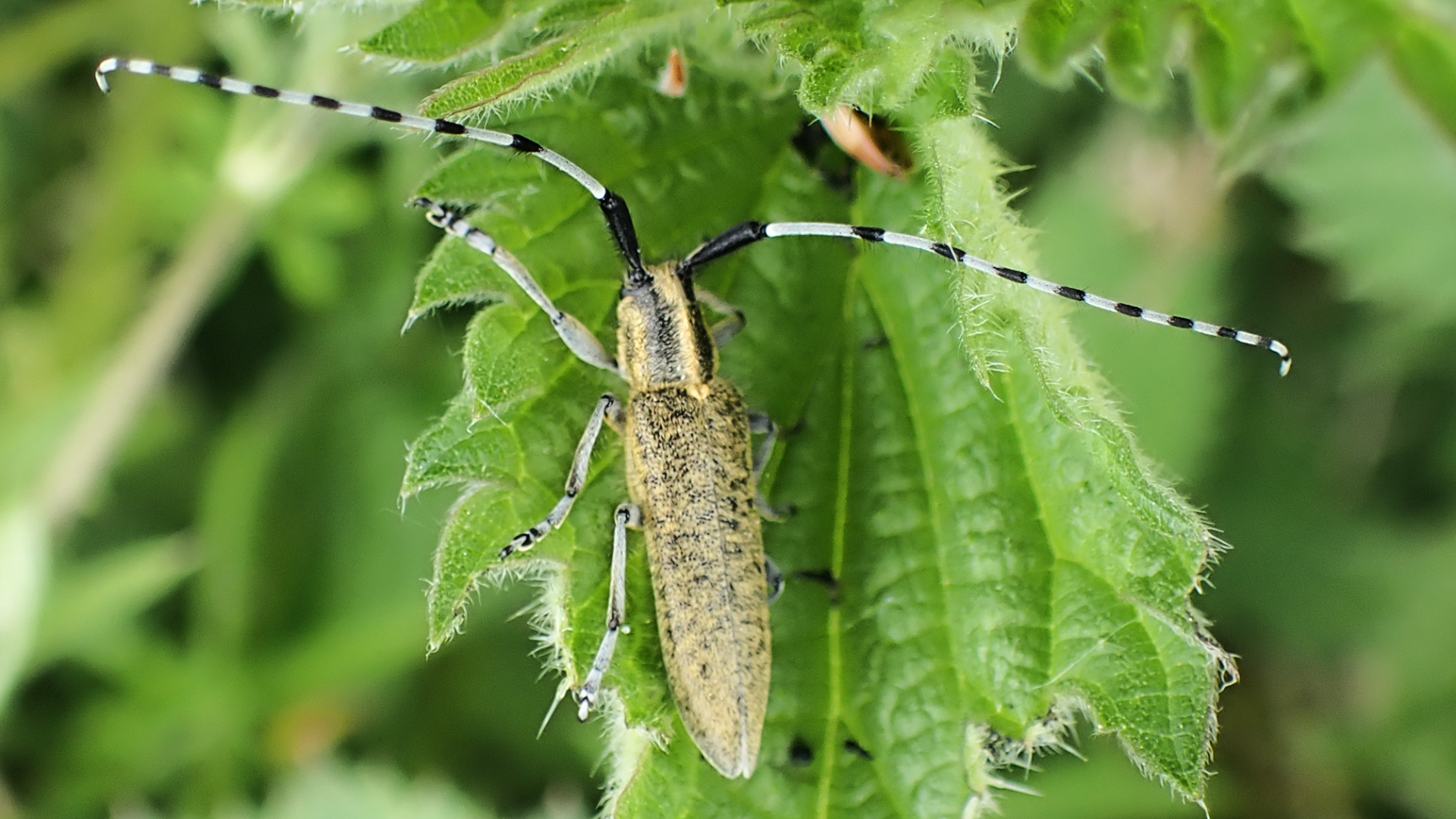
TQ4792 06/05/2025 ©Raymond Small
A bristly beetle (18-20mm) with banded antennae and golden elytra and thorax. Typically seen in meadows and hedgerows where nettles, hogweed and cow parsley grow during May and June.
Black and Red Froghopper
Cercopis vulnerata
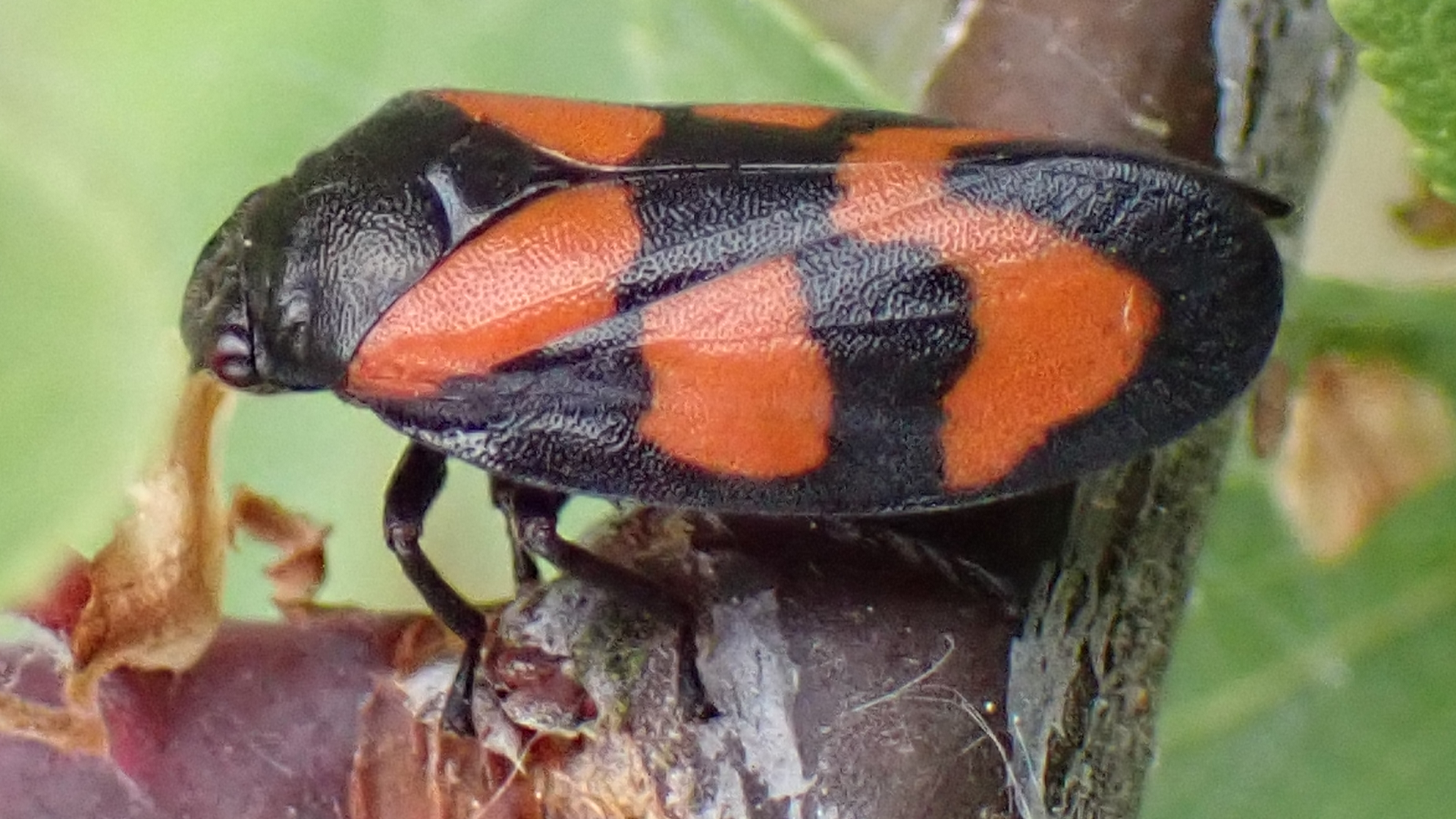
TQ4792 21/05/2025 ©Raymond Small
Nymphs of this large conspicuous froghopper are seldom seen because they feed on underground roots. Adults appear from April until August. They can be up to 11mm long.
Fine Streaked Bugkin
Miris striatus
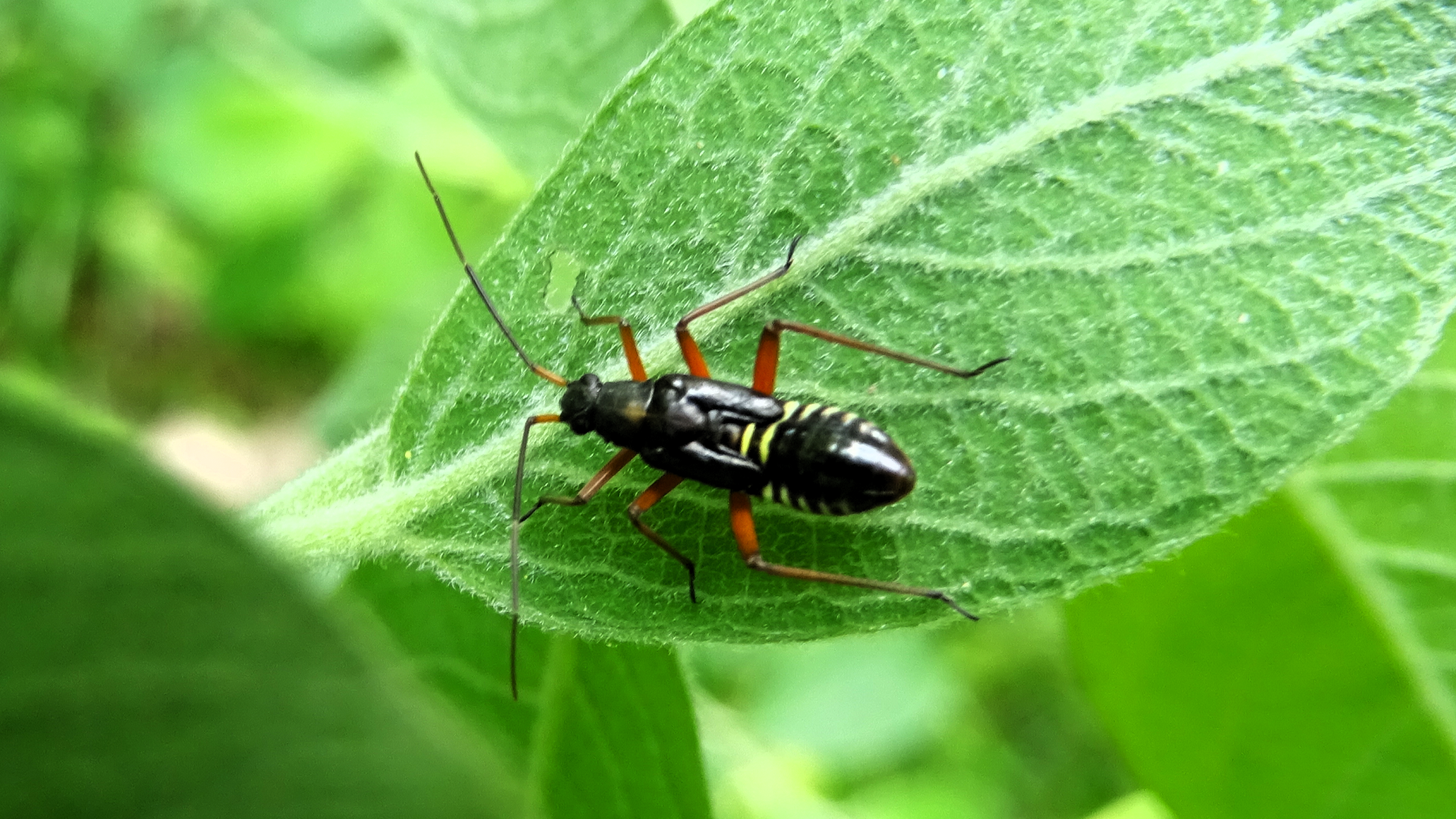
TQ4793 08/05/2025 ©Raymond Small
This distinctive predatory species is associated with Oak and Hawthorn. The dark ant-like nymphs have yellow markings and reddish-brown legs.

TQ4892 17/05/2025 ©Raymond Small
Adults (9-11mm) appear from May until July. They feed on aphids, eggs and larvae of other insects.
Striped Oak Bug
Rhabdomiris striatellus
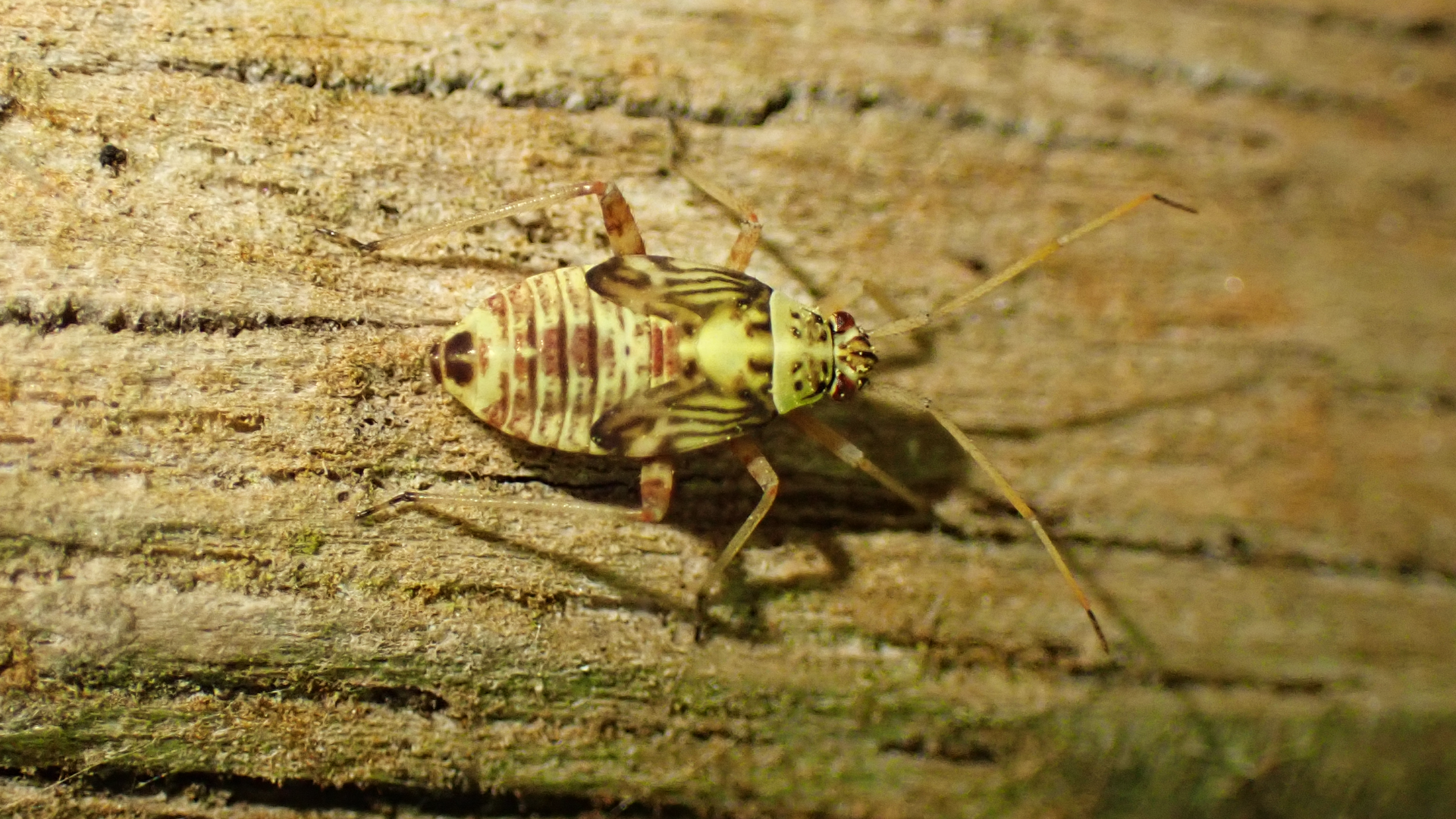
TQ4793 01/05/2025 ©Raymond Small
Nymphs emerge from overwintered eggs during April. They feed on unripe catkins and become adults from mid May onwards.
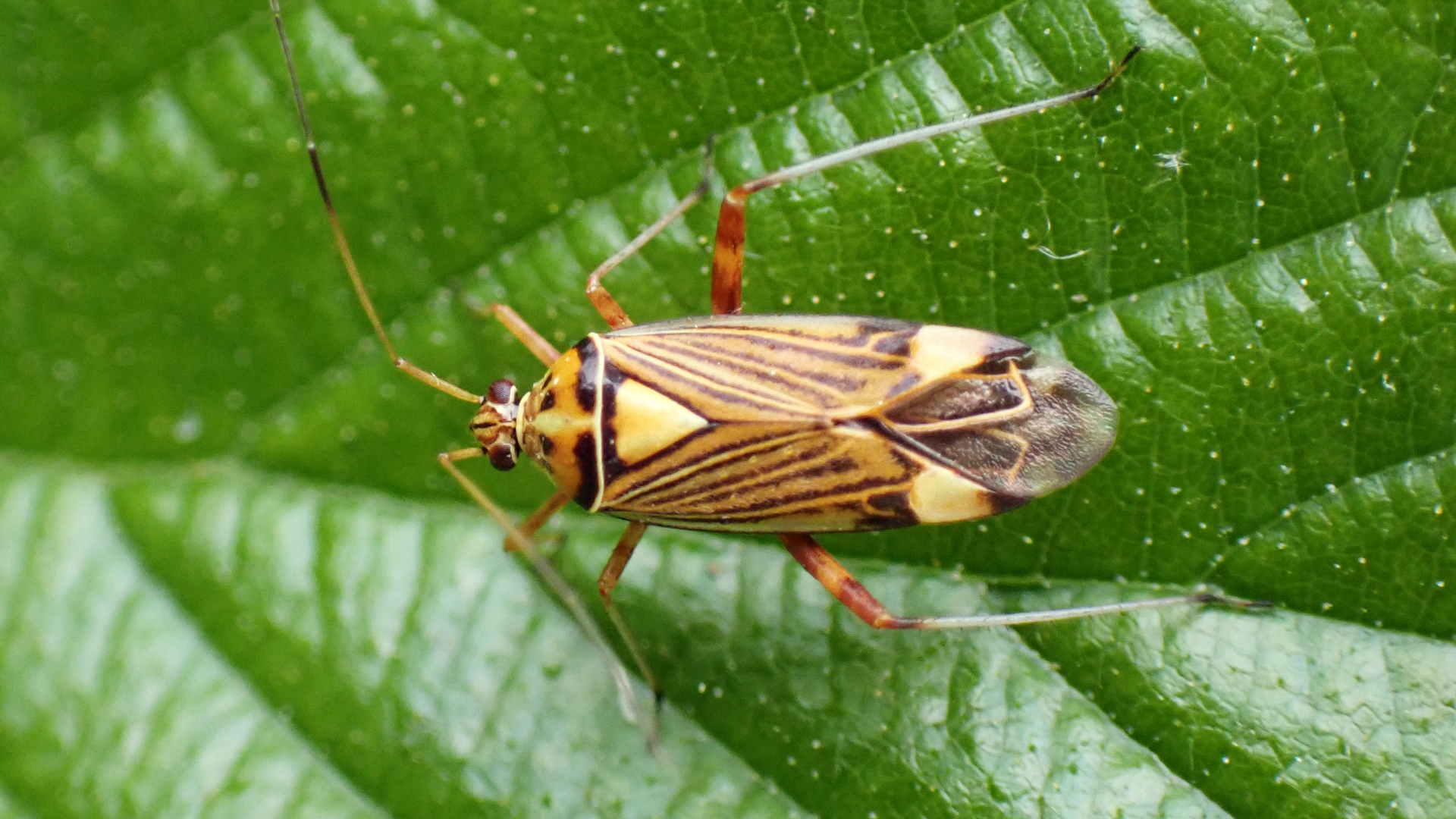
TQ4892 17/05/2025 ©Raymond Small
The distinctive adults (7-8mm) are seen from May to July. Males are normally darker than the females. This species is associated with oak.
Hypericum Rhopalid
Rhopalus subrufus
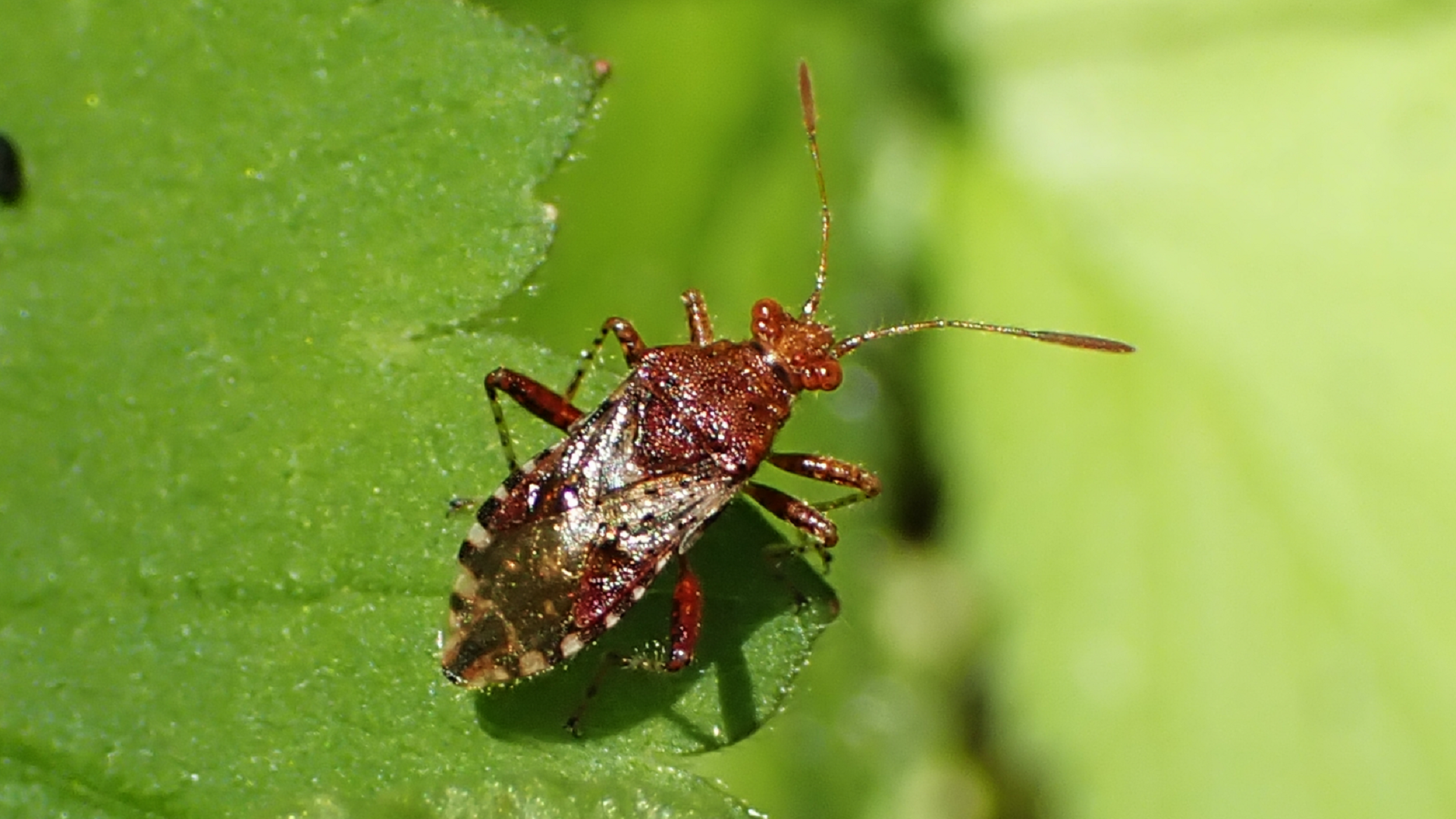
TQ4793 01/05/2025 ©Raymond Small
Hypericum Rhopalid is a bug associated with stinging nettles and woodland clearings. It is about 7mm long.
Gorse Shieldbug
Piezodorus lituratus
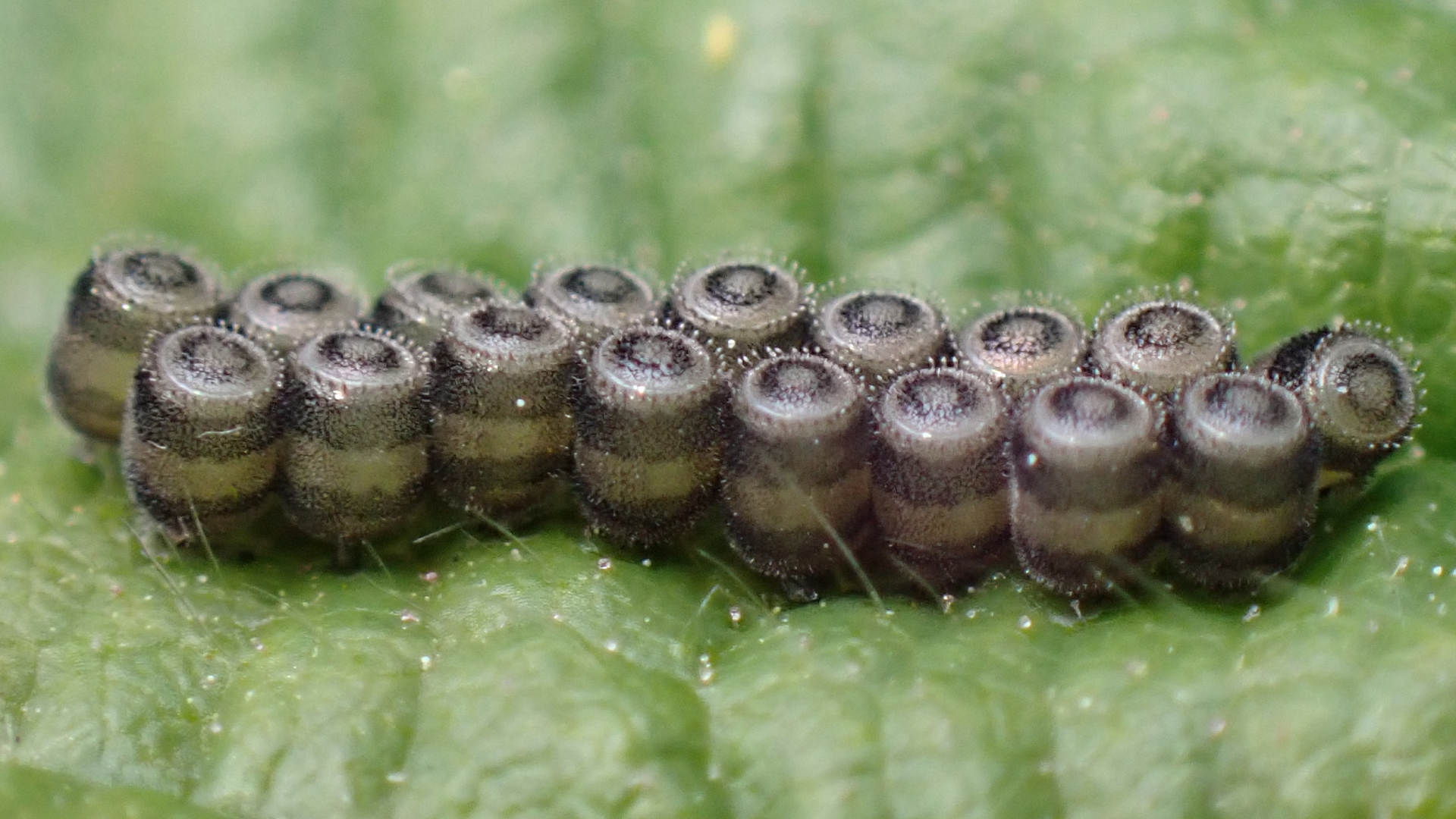
TQ4793 05/05/2025 ©Raymond Small
Seventeen barrel-shaped Gorse Shieldbug eggs. The line of eggs was roughly 8mm long.
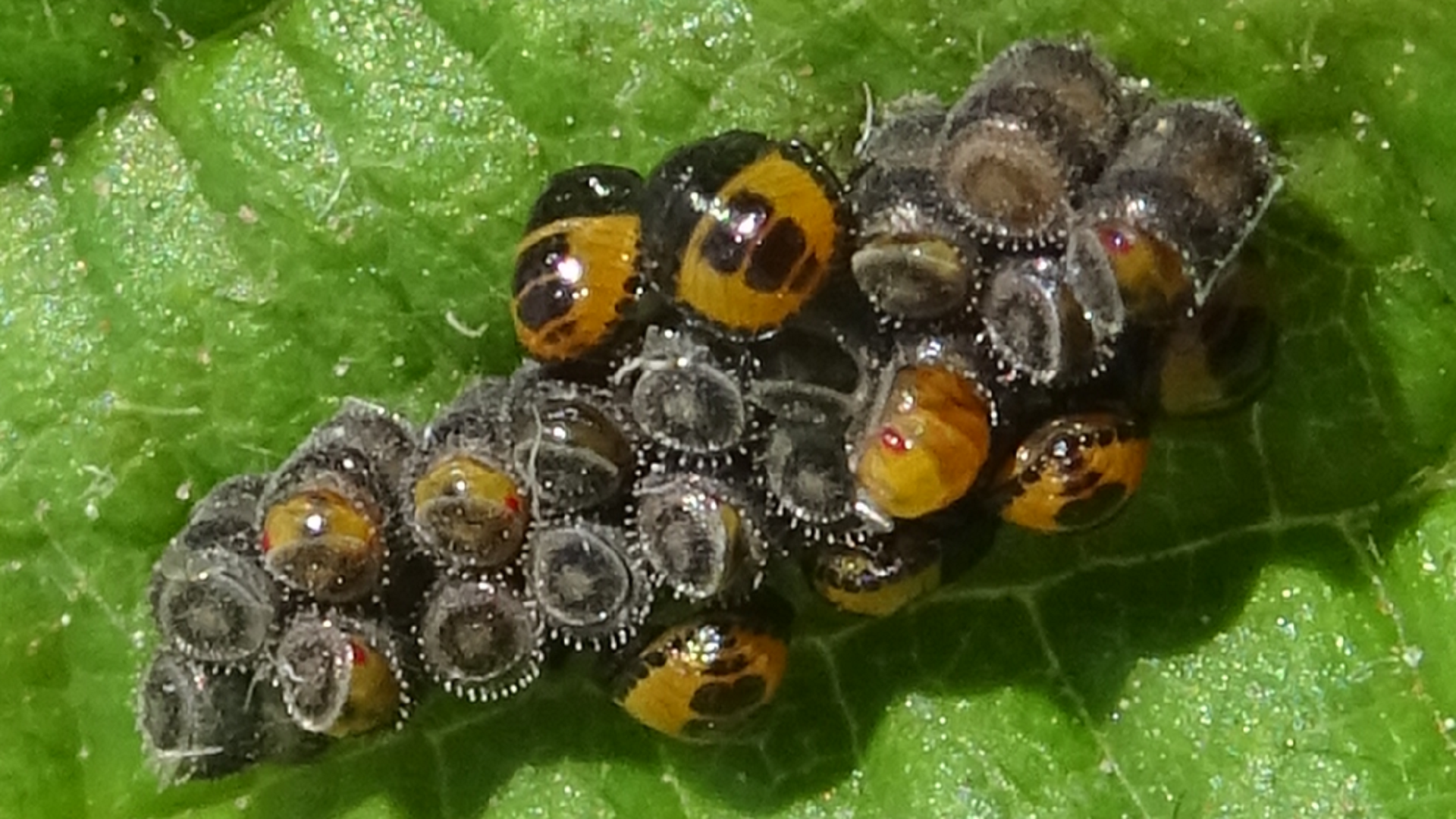
TQ4793 23/05/2025 ©Raymond Small
The eggs hatched and orange instars emerged. They will go through several stages before becoming adults. Foodplants they use include gorse, broom, and Dyer's greenweed.
Silver Birch Aphid
Euceraphis betulae

TQ4792 07/05/2025 ©Raymond Small
As its name implies this species is found on silver birch. Mainly green, however the body, antennae and legs of the adults may be coated in pale-blue wax giving a furry appearance. Several generations appear each year from spring to autumn. During summer all the adults are winged females that reproduce without mating in a process known as parthenogenesis. In autumn sexual reproduction takes place between winged males and wingless egg-laying females. The eggs overwinter and hatch the following spring.
Four-spotted Chaser
Libellula quadrimaculata
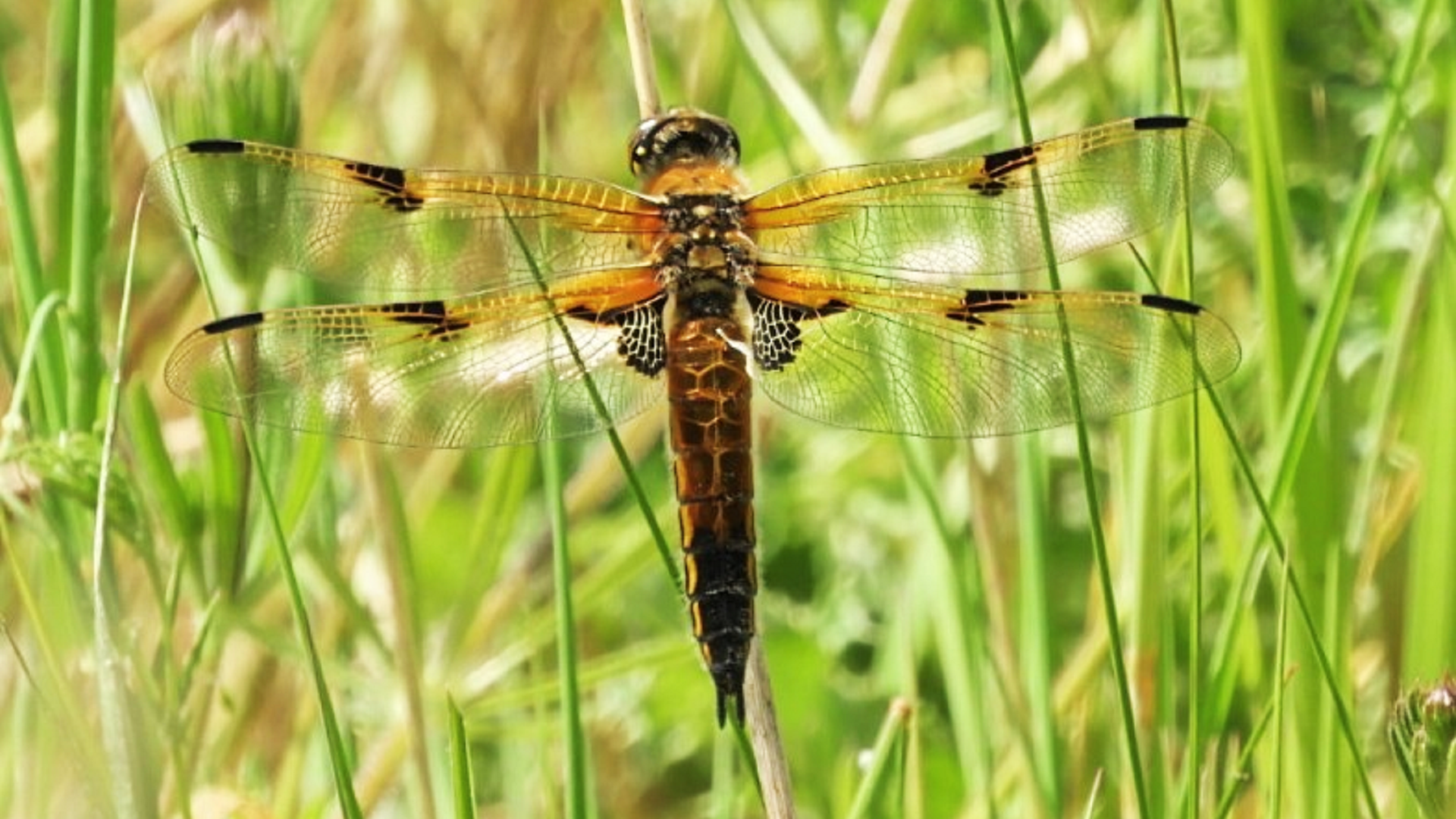
TQ4590 17/05/2025 ©Debi H
The Four-spotted Chaser is a dragonfly that flies from May until September often found hawking for insect-prey around heathland, lakes, ponds and woods. It gets its name from the two dark spots at the front edge of each wing. Males and females are golden-brown, darkening towards the tip of the body. There are yellow spots along the sides. Debi photographed this at Fairlop Waters.
Large Red Damselfly
Pyrrhosoma nymphula

TQ4793 10/05/2025 ©Mike Rumble
Generally one of the first damselfly species to emerge in spring usually near wetland habitats. Black legs rule this out from being the scarcer Small Red damselfly.
Apple Fruit Rhynchites
Tatianaerhynchites aequatus
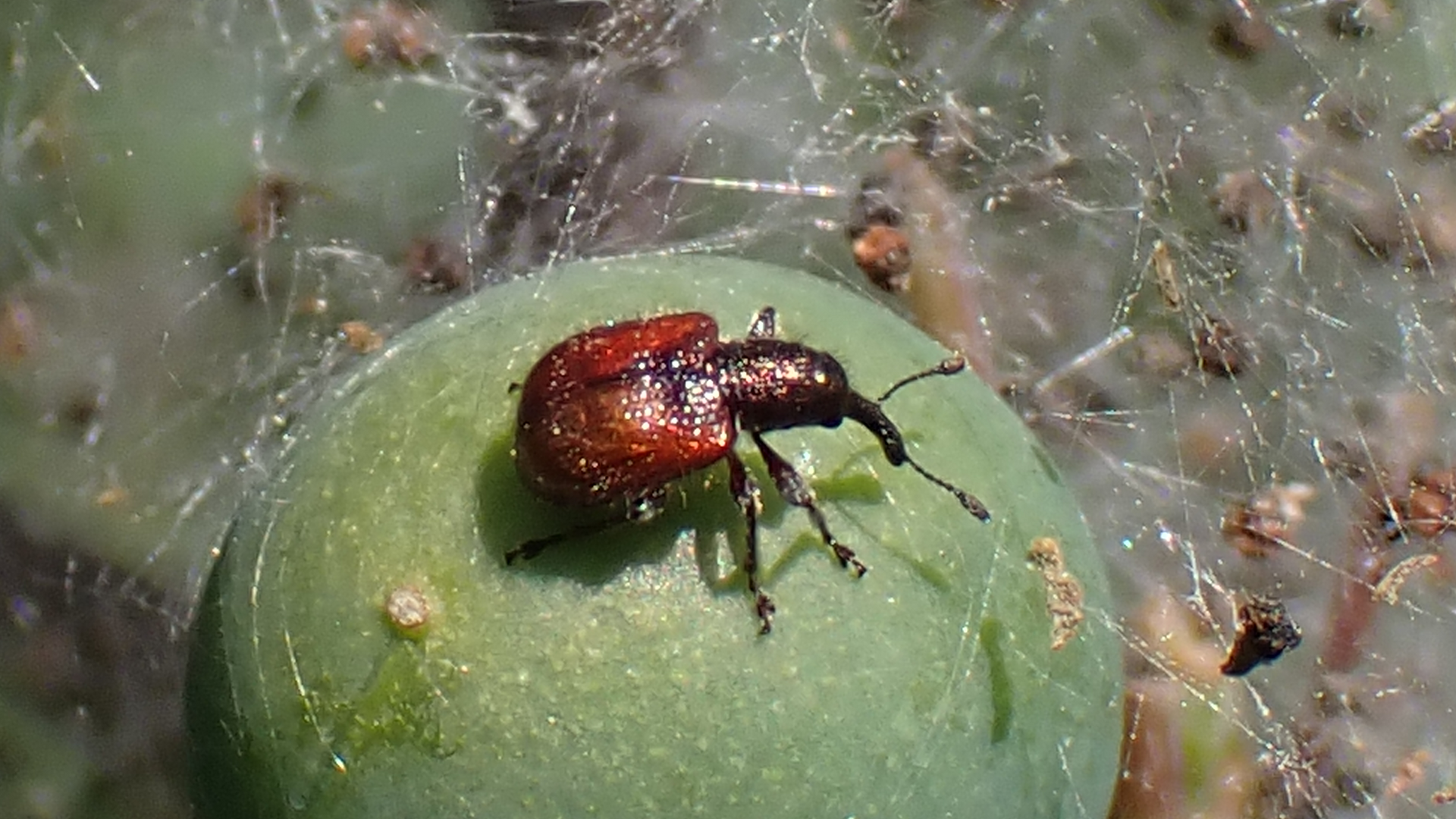
TQ4792 23/05/2025 ©Raymond Small
This hairy weevil is associated with blackthorn, hawthorn, apple, quince, almond, pear and rowan. The reddish-brown wing cases have a central dark line and are studded with rows of holes. This specimen was sitting on a sloe.
Beetle Elytron

Essex Field Club's County Recorder for Beetles, Rob Smith, sent this picture of a 7mm wing case he found on a dead beech trunk in Hainault Forest on April 10th. He is pretty sure it belonged to Rhinoceros beetle Sinodendron cylindricum, a species with only a few Essex records. Sightings are known to have been made at Grange Farm, Hatfield Forest, Theydon Bois, and Danbury Common. It would be good to find a live adult in Hainault Forest.
MOVIE
Brief encounters with Grass Snakes.
Walnut
Juglans regia

TQ4792 06/05/2025 ©Raymond Small
A Walnut tree that stood near Sheepwater is no longer there, however one still exists in Hainault Forest. Grown by Bob Cable and donated to the Country Park as a 3 year old sapling it was planted on 24th August 2009. Now well established the tree produced these yellow flowers in May.
Ransoms
Allium ursinum

TQ4793 01/05/2025 ©Raymond Small
Ransoms, also known as 'Wild Garlic', is not common in Hainault Forest. It has a preference for shaded damp places. Flowers on long narrow stalks form in clusters on top of triangular stems. The star-like flowers have six long narrow petals that taper to a point and six stamens bearing white anthers and white pollen. In the middle is a green three-lobed ovary.
Anemone Gall
Pseudoneuroterus saliens
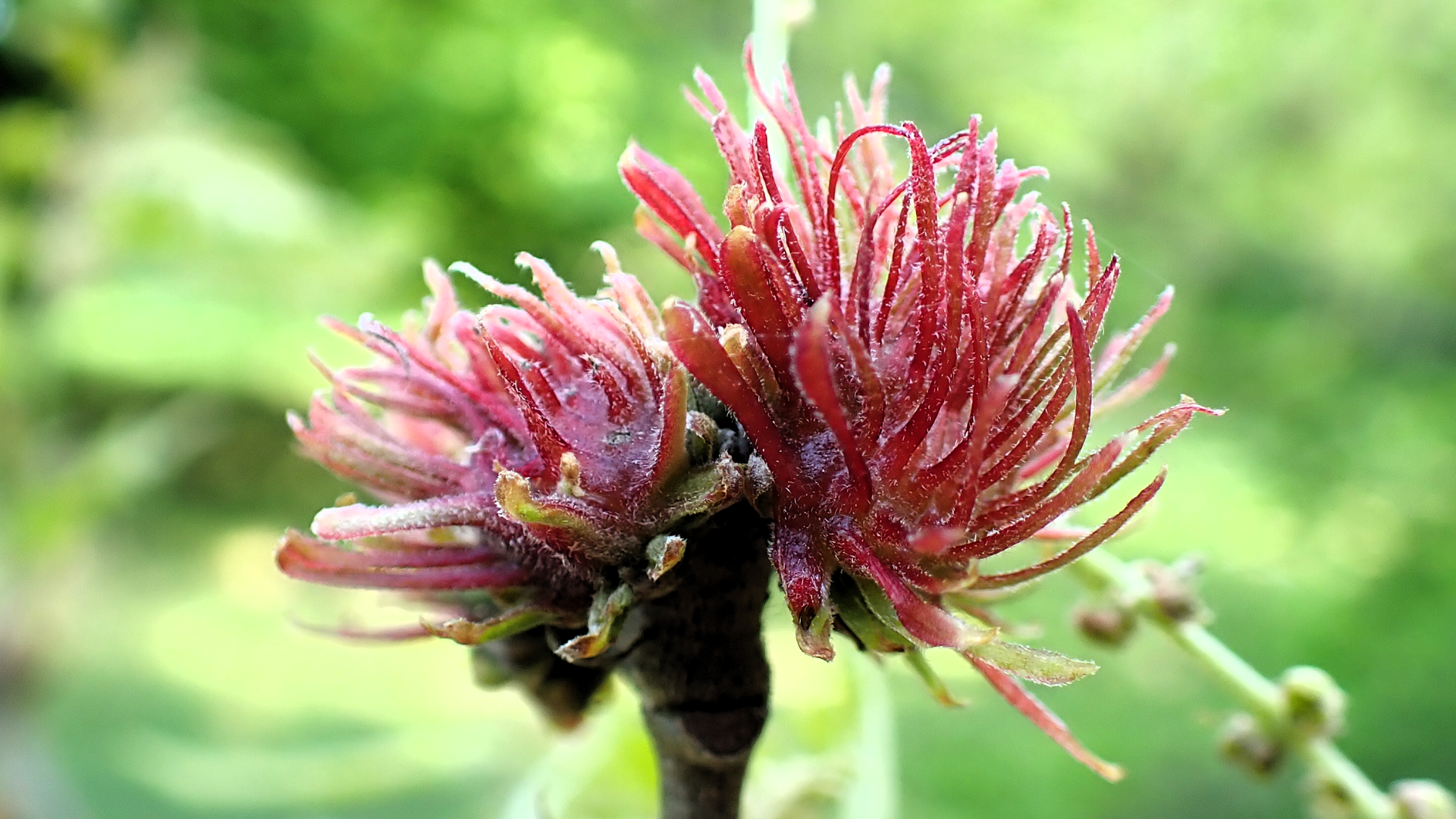
TQ4792 01/05/2025 ©Raymond Small
Anemone Galls form on fertilised Turkey oak female flowers. They are induced by the sexual generation of a gall wasp. Several larvae live in each gall and emerge as adults during summer. The first record of this gall in the UK was during 2004.
Cluster Gall
Andricus lucidus
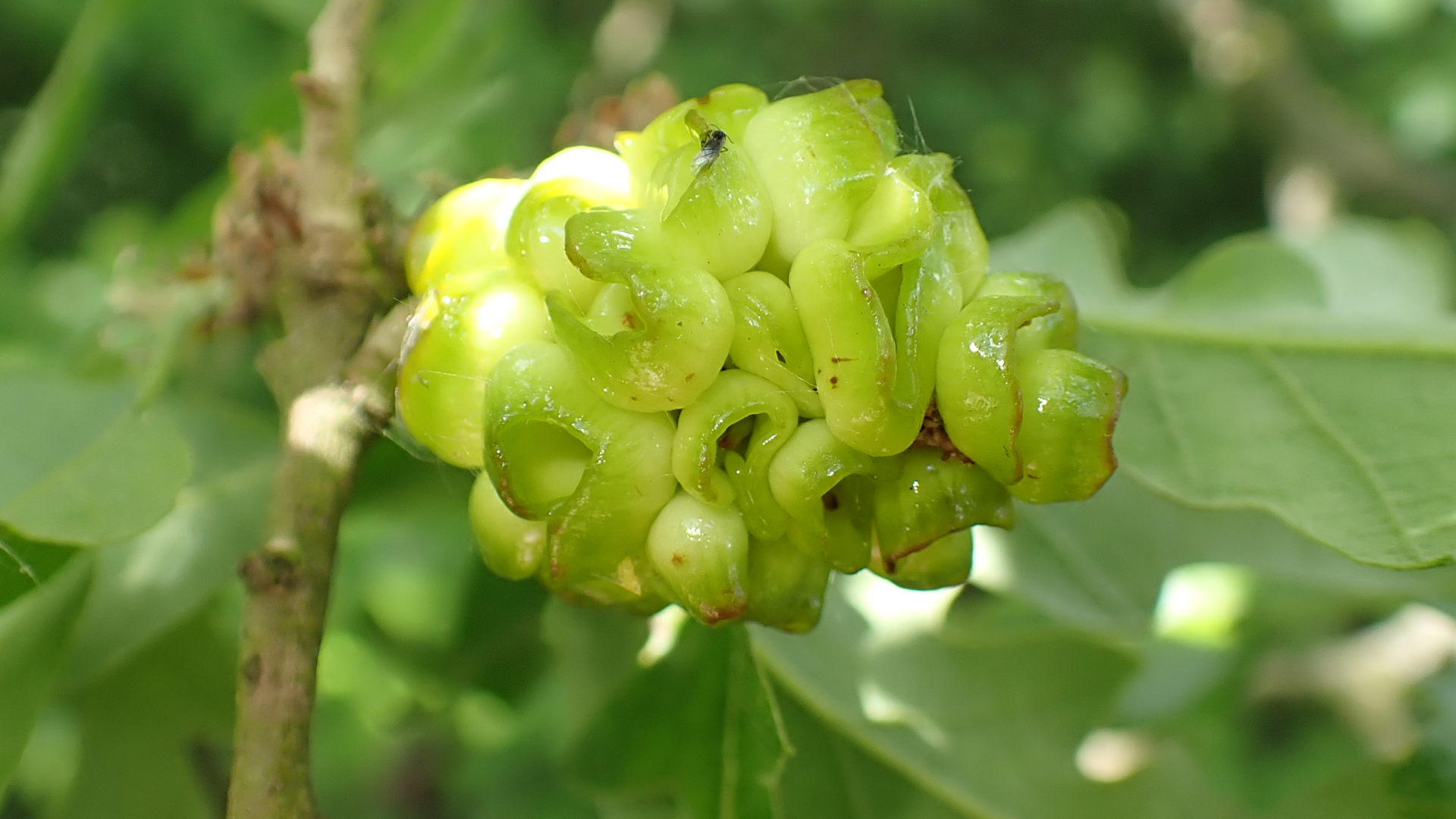
TQ4792 19/05/2025 ©Raymond Small
Cluster Galls first appeared in the UK during the 1990s, originating from the Mediterranean. These galls are caused by the sexual generation of a gall-wasp. The flower-like clusters, measuring up to 35mm across, are comprised of dish-shaped galls that push into each other. The galls are initially green with a shiny, waxy surface, becoming reddish-brown and hard. The asexual generation of this gall-wasp produce Hedgehog Galls.
MOVIE
Victory in Europe Day on May 8th 1945 celebrated the war ending in Europe. A flypast on May 5th 2025 marked the 80th anniversary. Crowds gathered in Hainault Forest to watch the display. This movie contains action sequences and stills of the flypast taken by Michael Trump, Mike Rumble and Raymond Small.
Thank you to everyone that has contributed this month.
The next Journal is expected 30th June 2025 or thereabouts!
© hainaultforest.net. All rights reserved.
This website uses necessary cookies. It does not use any targeting or advertising cookies.


